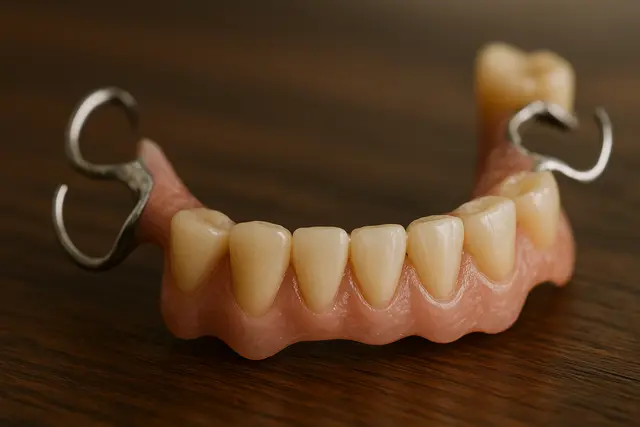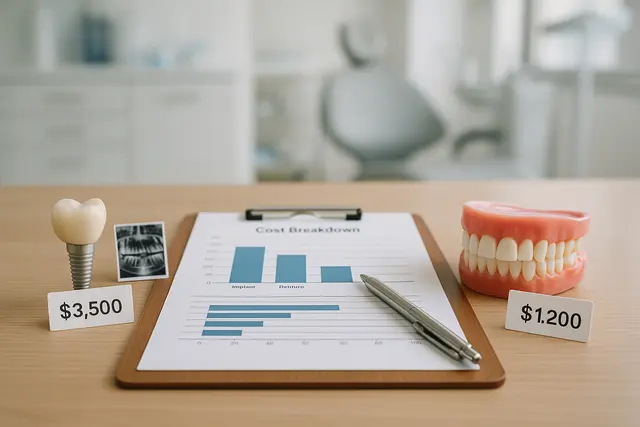Prosthodontics
6 min read
May 26, 2025
What Does a Partial Denture Look Like? Types, Materials, and Designs
Missing a tooth, or a few, can throw off more than just your smile. Chewing gets tricky, talking feels awkward, and let’s be honest, you probably avoid photos. That’s where partial dentures come in. Whether you’ve lost teeth to age, injury, or just plain bad luck, partial dentures offer a practical, natural-looking way to fill the gaps and get back to living comfortably.

Most people don’t wake up thrilled at the thought of getting a partial denture. But when you're missing one or more teeth and you’d like to chew, smile, and speak without worry, partial dentures offer a solid, trustworthy fix, and they don’t look nearly as clunky as you might imagine.
Partial Denture: What Are We Actually Talking About?
A partial denture is a removable dental appliance designed to replace one or more missing teeth. Unlike full dentures that take over the whole show, partial dentures are used when some natural teeth remain. Think of them as a supportive backup cast: they fill in the gaps left by missing teeth while working around your existing teeth like a well-choreographed dance partner.
Partial dentures are designed to restore both function and appearance. They're lightweight, shaped to match the natural teeth and gums, and often so well crafted that others won’t even know you’re wearing one, unless you decide to show them your new party trick.
Denture Basics: A Quick Refresher
Dentures are removable dental appliances that help replace missing teeth and surrounding tissues. When you’re missing just a few teeth, maybe from injury, decay, or age, a partial denture is often the go-to. These aren't your grandma’s dentures, either. Today's dentures typically fit better, last longer, and look much more like natural teeth.
Partial dentures are crafted with artificial teeth attached to a gum-colored base that blends in with your real gumline. The design of partial dentures is all about seamless integration. They’re made to restore your smile and your bite, without making your mouth feel like it’s hosting a foreign object.
Type of Partial Denture: Know Your Options
There’s no one-size-fits-all solution. The type of partial denture you get depends on your dental needs, budget, and lifestyle. Here's a quick breakdown:
Metal Partial: These use a thin, durable metal framework that clips to your existing teeth. They’re super sturdy and known for their snug fit, although they can sometimes be visible when you smile wide.
Flexible Partial: Made from a soft, bendy material, these are a fan favorite for comfort and aesthetics. They’re nearly invisible when worn and ideal for people who can’t tolerate traditional designs.
Fixed Partial (aka Dental Bridge): Unlike removable types, a fixed partial denture is cemented in place and supported by nearby natural teeth. It doesn’t come out, which makes cleaning important, but hey, no chance of forgetting it on your nightstand.
Removable partial dentures are also still incredibly popular due to their ease of cleaning and lower cost compared to fixed options. And yes, there are also acrylic versions, which tend to be bulkier but make a decent short-term solution.
Lower Partial Dentures: The Unsung Heroes of the Lower Jaw
Lower partial dentures are designed to work around the remaining teeth in your lower jaw. Whether you're missing one or several lower teeth, this type of denture is custom-made to fit your mouth's shape and bite.
Lower partial dentures can also be flexible or metal-based, depending on your needs. They sit along your lower gumline and use clasps to hug your natural teeth. While eating with them might feel odd for a day or two, most wearers adapt quickly. Lower partial dentures are designed to feel as natural as possible, and when done right, they blend seamlessly with your existing teeth.
Curious what lower partial dentures look like? Picture a thin horseshoe-shaped frame that supports artificial teeth, resting gently in place and anchored by your natural teeth. Not exactly glamorous, but undeniably practical.
Upper Partial Dentures: Filling the Smile Gap
Upper partial dentures are designed for the upper jaw. These usually include a base that fits against the roof of your mouth and supports the artificial teeth and rests. Some versions rely on metal clasps, while others use less noticeable materials to keep the look natural.
Partial dentures for front teeth fall into this category and are especially crafted for maximum aesthetics. These are the ones you want when the gap is front-and-center and every selfie counts. Upper partial dentures are crafted with incredible detail so they match your remaining teeth and gums, because no one wants their tooth replacement to look like it came from a costume shop.
Tooth Talk: Why It Matters
Losing a tooth might seem like no big deal, until you try to eat corn on the cob or pronounce “snack.” Teeth can significantly affect how we talk, eat, and feel about ourselves. Partial dentures help bring back that functionality.
Artificial teeth used in partial dentures are made to look and feel as close to natural as possible. They’re shaped, shaded, and aligned to fit right in with the rest of your mouth. This not only helps you chew but prevents remaining teeth from shifting around, which can throw off your whole bite.
Dental Solutions for Missing Teeth
If you’re considering partial dentures, you might also hear about dental bridges or dental implants. A dental bridge is a fixed solution, usually anchored to surrounding teeth, while implants are surgically placed into the jawbone. While those are great options for some, partial dentures are often a faster, more affordable fix, especially when multiple teeth are missing in different areas.
Partial dentures are also used when some natural teeth remain, offering a middle-ground solution for individuals missing one or more teeth without requiring surgery or long recovery times.
Partial Dentures for Front Teeth: It’s All About the Smile
Missing front teeth? That’s a tough one. But here’s the good news: partial dentures for front teeth are designed to look natural, fit comfortably, and restore your confidence. Whether you’re replacing one or several teeth, the base supports the artificial teeth in a way that feels secure and looks like the real thing. Plus, they help support your lip structure, so your face keeps its shape, too.
Benefits of Partial Dentures: More Than Just a Pretty Smile
Here’s where partial dentures shine:
They replace one or more missing teeth without the cost or invasiveness of implants.
They help keep your remaining teeth from shifting.
They’re removable, so cleaning is easy.
They restore bite, chew strength, and speech.
And they offer a natural look that feels like you again.
Partial dentures offer a practical solution for individuals missing one or more teeth, especially when the goal is a quick return to daily life with minimal hassle. And when partial dentures are made by a skilled dental professional, you’re in good hands.
How Partial Dentures Work (and Keep Working)
Partial dentures are crafted to work with your natural teeth and gums. They typically use clasps or precision attachments to stay in place, and they’re meant to be worn daily but removed at night. Wearing your partial denture regularly helps maintain its shape and fit.
With good dental care and regular cleanings, partial dentures can last several years. The life of your partial denture also depends on how well you treat it, so don’t skip those brushing routines, and be gentle during cleanings.
Final Thoughts
Partial dentures are often underestimated. But they’re not just fake teeth; they’re a way back to eating steak, laughing without covering your mouth, and biting into life with a little more gusto. Whether you’re missing one or several teeth, partial dentures serve as a reliable, affordable, and confidence-restoring dental prosthetic.
And if you’re still unsure? Consider consulting with a dental professional. They’ll walk you through the types, materials, and cost of partial dentures, and help you decide what fits your smile best.
What Is a Partial Denture and How Does It Work?
A partial denture is a removable appliance that replaces one or more missing teeth while fitting around your existing natural teeth. It restores both the function and appearance of your smile using artificial teeth attached to a gum-colored base, often secured with small clasps or precision attachments.
What Types of Partial Dentures Are Available?
Partial dentures come in several types, including metal framework dentures (durable and secure), flexible partials (comfortable and natural-looking), and acrylic versions (affordable but bulkier). Fixed options like dental bridges are also available if you're looking for something non-removable.
How Do Upper and Lower Partial Dentures Differ?
Upper partial dentures are designed to rest on the roof of your mouth and often replace front teeth for aesthetics, while lower partials sit along the lower gumline and must accommodate tongue space. Both are custom-fitted to blend with your natural teeth and provide stability while eating and speaking.
Do Partial Dentures Look Natural and Feel Comfortable?
Yes, when properly made, partial dentures are shaped and shaded to match your natural teeth and gums. Flexible materials improve comfort, and the fit is customized to your bite. While there may be a short adjustment period, most people adapt quickly and enjoy renewed confidence.
Read Next
Related Posts

Prosthodontics
How to Choose Between Dentures and Implants for Tooth Replacement
Losing teeth can be a tough experience, physically, emotionally, and socially. Fortunately, modern dentistry offers reliable solutions to restore both function and confidence. Among the most popular options are dentures and dental implants, each with its own advantages depending on your needs, health, and lifestyle.
6 min read
Oct 21, 2025

Prosthodontics
Single Tooth Implant vs. Bridge: Pros and Cons
Missing a tooth can feel overwhelming, but you're not alone. Whether it’s from an injury, decay, or an unexpected mishap, choosing the right way to replace it is a big decision. Two of the most common options are dental implants and bridges, each with its own benefits and trade-offs. Understanding the differences can help you make a confident, informed choice for your smile and long-term oral health.
5 min read
Oct 21, 2025

Prosthodontics
Tooth Implant vs. Denture: Cost Effectiveness
Choosing between dental implants and dentures isn’t just a financial decision, it’s about finding the right fit for your lifestyle, oral health, and long-term comfort. While both options aim to restore your smile and function, they differ significantly in durability, cost, and impact on your overall well-being.
4 min read
Oct 21, 2025
Don’t have time to research every dentist around you?
See why 30k+ patients trusted us